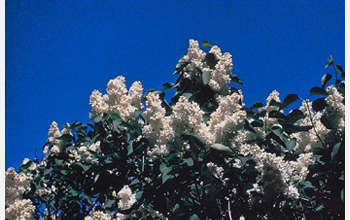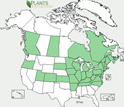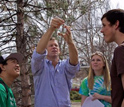News Release 10-061
Volunteers Scrutinize "Ten Most Wanted" Plants for Clues to Climate Change
Project Budburst citizen scientists find that plants are blooming unusually early

Volunteers are tracking spring blooming dates of trees and flowers like lilacs.
April 19, 2010
This material is available primarily for archival purposes. Telephone numbers or other contact information may be out of date; please see current contact information at media contacts.
Students, gardeners, retirees and other volunteers across the nation who are taking part in a nationwide initiative--Project BudBurst--are finding hints that certain plants are blooming unusually early, perhaps as a result of climate change.
The citizen scientists are recording the timing of flowers and foliage, amassing thousands of observations from across the nation to give researchers a detailed picture of our changing climate.
The project, which started as a pilot program in 2007, now focuses on a list of the "10 most wanted species"--flowers and trees such as the common lilac, red maple and Virginia bluebell.
Such widely distributed plants can provide important early signs of the impact of warming temperatures on the environment, according to the scientists who designed the project.
"Project BudBurst empowers people living anywhere in the country to make a contribution that will lead to better understanding of our environment," said Project BudBurst director Sandra Henderson of the University Corporation for Atmospheric Research (UCAR) Office of Education and Outreach. "This is needed data to help scientists who are studying the impacts of climate change."
Project BudBurst is operated by UCAR and the Chicago Botanic Garden, and is a partner in the USA National Phenology Network.
Funding comes from the National Science Foundation (NSF), along with the U.S. Fish and Wildlife Service, U.S. Geological Survey, U.S. Forest Service, National Ecological Observatory Network, NASA and the National Geographic Education Foundation.
"While these observations may reveal impacts of climate change in local areas, scientists need data from many more locations," said Elizabeth Blood, program director in NSF's Directorate for Biological Sciences, which funds Project BudBurst. "Scientists also need more years of data to understand changes over larger regional scales, as well as distinguish the effects of long-term trends in climate from natural year-to-year variations."
In Chicago, volunteers who have observed 15 kinds of plants since 2007 have found that seven of them are flowering earlier now than at any time in more than 50 years of observations by botanists.
"We will need volunteers to make observations for a number of years before we can fill in an accurate picture about the impact of climate change on our landscape," Henderson says.
Volunteers say they enjoy making the observations.
"Where there are curious people, it doesn't take long to bring together a group to go scrutinizing particular plants and trees, discovering the earliest stages of cones or bud formation, for instance, then following the later development," said Sue Prindle, who lives in a retirement community in Silver Spring, Md. "It has been rewarding and fun."
Overall, participants across the country have made more than 10,000 observations since 2007, establishing a baseline for the timing of key plant events.
"These findings are important as scientists analyze the impacts of global warming on our natural world," says Kayri Havens, a senior scientist with the Chicago Botanic Garden and co-manager of Project BudBurst.
Each participant in Project BudBurst selects one or more plants to observe.
The Project BudBurst Web site encourages volunteers to focus on the 10 most wanted species, but it also welcomes observations of other plants.
Volunteers begin checking their plants at least a week prior to the average date of budburst--the point when the buds have opened and leaves are visible.
After budburst, participants continue to observe the tree or flower for later events, such as seed dispersal and autumn leaf dropoff. Participants submit their records of these phenophases online.
Anyone can view the results as maps of the phenophases across the United States.
The science of phenology, or tracking cyclic behavior among plants and animals, has a distinguished history.
For centuries farmers, naturalists, geographers and others have kept careful records of the phenology patterns of plants and animals.
Farmers have long used their phenology knowledge to predict the best time for planting and harvesting crops, when to start expecting problems with insect pests, and other seasonal events.
The effects of climate change on numerous plant and animal species throughout the world have been observed and reported in the scientific literature.
Some plants respond to warmer temperatures by extending their growing seasons. Others shift their ranges toward the poles or to higher elevations.
At the same time, many insects breed and disperse based on regular cycles of sunlight rather than temperature.
This can cause a mismatch between the behavior of pollinating insects, such as bees, and flowers that bloom earlier than the insects expect. Such asynchronous behavior has already been noted across many parts of the world.
-NSF-
-
The current distribution of lilacs is shown (in green); the trees' range may be changing.
Credit and Larger Version -
NSF biologist Buck Sanford, on leave from University of Denver, collects data for Project BudBurst.
Credit and Larger Version
Media Contacts
Cheryl Dybas, NSF, (703) 292-7734, email: cdybas@nsf.gov
David Hosansky, NCAR, (303) 497-8611, email: hosansky@ucar.edu
The U.S. National Science Foundation propels the nation forward by advancing fundamental research in all fields of science and engineering. NSF supports research and people by providing facilities, instruments and funding to support their ingenuity and sustain the U.S. as a global leader in research and innovation. With a fiscal year 2023 budget of $9.5 billion, NSF funds reach all 50 states through grants to nearly 2,000 colleges, universities and institutions. Each year, NSF receives more than 40,000 competitive proposals and makes about 11,000 new awards. Those awards include support for cooperative research with industry, Arctic and Antarctic research and operations, and U.S. participation in international scientific efforts.
Connect with us online
NSF website: nsf.gov
NSF News: nsf.gov/news
For News Media: nsf.gov/news/newsroom
Statistics: nsf.gov/statistics/
Awards database: nsf.gov/awardsearch/
Follow us on social
Twitter: twitter.com/NSF
Facebook: facebook.com/US.NSF
Instagram: instagram.com/nsfgov




